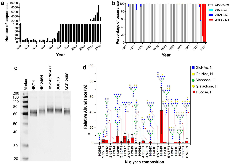The neuraminidase of A(H3N2) influenza viruses circulating since 2016 is antigenically distinct from the A/Hong Kong/4801/2014 vaccine strain
- US Food and Drug Administration (FDA), Silver Spring, MD (United States)
- Centers for Disease Control and Prevention (CDC), Atlanta, GA (United States)
- National Inst. for Biological Standards and Control, Potters Bar (United Kingdom)
- Univ. of Chicago, IL (United States)
- Icahn School of Medicine at Mount Sinai, New York, NY (United States)
- Mississippi State Univ., Starkville, MS (United States)
A(H3N2) virus predominated recent influenza seasons, which has resulted in the rigorous investigation of haemagglutinin, but whether neuraminidase (NA) has undergone antigenic change and contributed to the predominance of A(H3N2) virus is unknown. In this work, we show that the NA of the circulating A(H3N2) viruses has experienced significant antigenic drift since 2016 compared with the A/Hong Kong/4801/2014 vaccine strain. This antigenic drift was mainly caused by amino acid mutations at NA residues 245, 247 (S245N/S247T; introducing an N-linked glycosylation site at residue 245) and 468. As a result, the binding of the NA of A(H3N2) virus by some human monoclonal antibodies, including those that have broad reactivity to the NA of the 1957 A(H2N2) and 1968 A(H3N2) reference pandemic viruses as well as contemporary A(H3N2) strains, was reduced or abolished. This antigenic drift also reduced NA-antibody-based protection against in vivo virus challenge. X-ray crystallography showed that the glycosylation site at residue 245 is within a conserved epitope that overlaps the NA active site, explaining why it impacts antibody binding. Our findings suggest that NA antigenic drift impacts protection against influenza virus infection, thus highlighting the importance of including NA antigenicity for consideration in the optimization of influenza vaccines.
- Research Organization:
- Argonne National Laboratory (ANL), Argonne, IL (United States). Advanced Photon Source (APS)
- Sponsoring Organization:
- USDOE Office of Science (SC); US Food and Drug Administration (FDA); Centers for Disease Control and Prevention (CDC); National Institute of Allergy and Infectious Disease (NIAID); National Institutes of Health (NIH)
- Grant/Contract Number:
- U19AI082724; U19AI109946; U19AI057266; R01AI116744; HSN272201400008C; HHSN272201400005C
- OSTI ID:
- 1599430
- Journal Information:
- Nature Microbiology, Vol. 4, Issue 12; ISSN 2058-5276
- Publisher:
- Nature Publishing GroupCopyright Statement
- Country of Publication:
- United States
- Language:
- ENGLISH
Web of Science
Similar Records
Broadly protective human antibodies that target the active site of influenza virus neuraminidase
A Novel Recombinant Influenza Virus Neuraminidase Vaccine Candidate Stabilized by a Measles Virus Phosphoprotein Tetramerization Domain Provides Robust Protection from Virus Challenge in the Mouse Model




